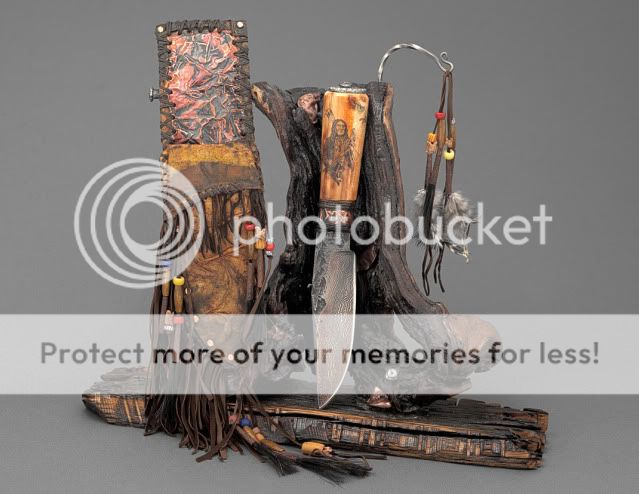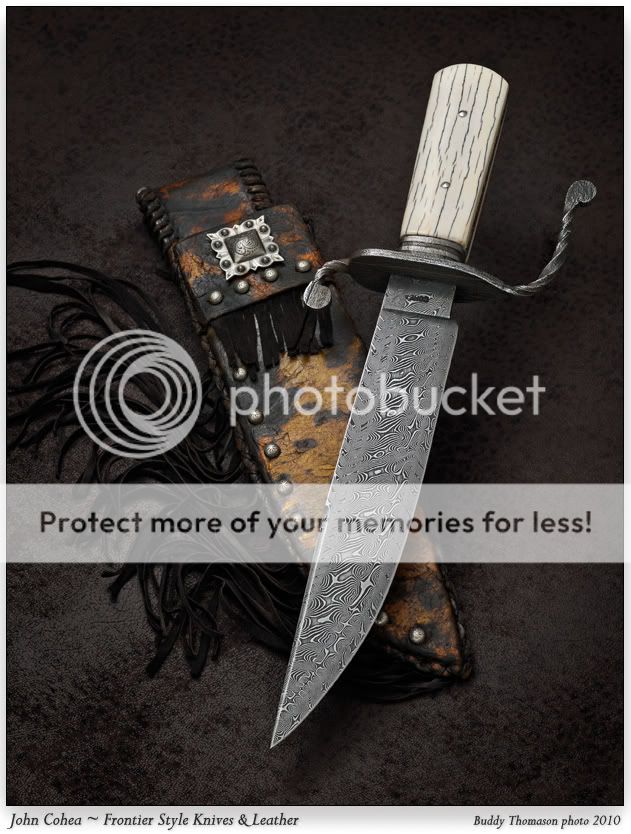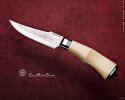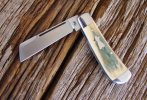- Joined
- Dec 20, 2009
- Messages
- 4,421
I think that it would be beneficial for us to look at some ivory handled knives for a few reasons.
A few misunderstandings about the use of ivory on knives might be cleared up if we look at some knives and discuss them.
If we look at the issue objectively we might see how common ivory is on knives both historically and now. It might demonstrate how easy it is to tell the vast majority of knives using mammoth ivory from elephant ivory. We might get an idea of how many knife owners and makers might be affected by a ban on the sale of ivory, both elephant and mammoth.
So lets see some knives, if you own an ivory handled knife post a picture of it. Let us know what kind of ivory it is, how you know that, how much the knife might be worth (if you want to), how old it is and how you came to own it (bought it, inherited it etc.) I'd like to see antique knives, modern knives, cheap ones and expensive ones. They need to be with ivory, any kind of ivory, mammoth, elephant, walrus, hippo tooth, warthog tooth or narwhal.
If you don't own any, but have made some, show us those too.
My intent with this thread is not to have another discussion about whether or not we should use ivory, I would like to stick to things like identification, the kind of people that have them and how many people might be effected by bans.
If you are going to be rude, please don't post in this thread. You should be able to make your point without being snarky about it.
I will start with some of mine.

This is a handle of ancient walrus ivory. It is easily differentiated from elephant ivory because we can see the core of the walrus tusk in the center on the butt of this knife. If this was a handle of mammoth ivory we would be able to measure the angle of the Schreger lines on the but to know whether it was elephant or mammoth.

This knife has a handle with the end grain of the ancient walrus ivory exposed. You're looking at all end grain in the scale pattern. It's easy to tell that this is walrus because we can see the core. It's easy to tell that it's ancient because it has all that color.

This handle, starting at the guard, is of mammoth tooth, and blue mammoth ivory with a slash of musk ox horn through it.
It's important to note that all the ivory in my post is naturally colored, there is no artificial coloring on any of these handles. The blue coloring in this ivory is from a mineral called vivianite that grows (the vivianite crystals grow), when conditions are right, on bone and ivory. It takes thousands of years to get the coloring. It's near impossible to fake coloring in ivory, people have tried to do it but it's pretty easy to tell the fakes.

This handle has mammoth tooth, fossil walrus ivory and musk ox horn with an oval inlay of blue mammoth ivory. It's pretty easy to tell the ivory in this handle is not elephant ivory.

This is a blurry picture but I used it because it's an example of interior mammoth ivory. These would be the hardest to tell from elephant ivory but interior mammoth ivory makes up a very small percentage of the ivory handled knives made. To those that know what to look for, the color and the cracks in these pieces would tell us that this is mammoth, not elephant. Of the several hundred knives I have made, these are the only ones I have made that could be mistaken for elephant. The vast majority of knives made with mammoth ivory today are made using the "bark" of the tusk which is easily discernible from elephant ivory

This knife was made with documented pre-act elephant ivory, there is a paper trail for the ivory in this knife that would tell anybody, that needed to know, what the origin of the ivory is. (I did not make this knife)

These knives have mammoth ivory bark on the handles, again, very easy to tell from elephant ivory.
Please feel free to post pictures of ivory handled knives here. It would be nice to get an idea of the numbers of knives made with ivory that could be mistaken for elephant ivory.
A few misunderstandings about the use of ivory on knives might be cleared up if we look at some knives and discuss them.
If we look at the issue objectively we might see how common ivory is on knives both historically and now. It might demonstrate how easy it is to tell the vast majority of knives using mammoth ivory from elephant ivory. We might get an idea of how many knife owners and makers might be affected by a ban on the sale of ivory, both elephant and mammoth.
So lets see some knives, if you own an ivory handled knife post a picture of it. Let us know what kind of ivory it is, how you know that, how much the knife might be worth (if you want to), how old it is and how you came to own it (bought it, inherited it etc.) I'd like to see antique knives, modern knives, cheap ones and expensive ones. They need to be with ivory, any kind of ivory, mammoth, elephant, walrus, hippo tooth, warthog tooth or narwhal.
If you don't own any, but have made some, show us those too.
My intent with this thread is not to have another discussion about whether or not we should use ivory, I would like to stick to things like identification, the kind of people that have them and how many people might be effected by bans.
If you are going to be rude, please don't post in this thread. You should be able to make your point without being snarky about it.
I will start with some of mine.

This is a handle of ancient walrus ivory. It is easily differentiated from elephant ivory because we can see the core of the walrus tusk in the center on the butt of this knife. If this was a handle of mammoth ivory we would be able to measure the angle of the Schreger lines on the but to know whether it was elephant or mammoth.

This knife has a handle with the end grain of the ancient walrus ivory exposed. You're looking at all end grain in the scale pattern. It's easy to tell that this is walrus because we can see the core. It's easy to tell that it's ancient because it has all that color.

This handle, starting at the guard, is of mammoth tooth, and blue mammoth ivory with a slash of musk ox horn through it.
It's important to note that all the ivory in my post is naturally colored, there is no artificial coloring on any of these handles. The blue coloring in this ivory is from a mineral called vivianite that grows (the vivianite crystals grow), when conditions are right, on bone and ivory. It takes thousands of years to get the coloring. It's near impossible to fake coloring in ivory, people have tried to do it but it's pretty easy to tell the fakes.

This handle has mammoth tooth, fossil walrus ivory and musk ox horn with an oval inlay of blue mammoth ivory. It's pretty easy to tell the ivory in this handle is not elephant ivory.

This is a blurry picture but I used it because it's an example of interior mammoth ivory. These would be the hardest to tell from elephant ivory but interior mammoth ivory makes up a very small percentage of the ivory handled knives made. To those that know what to look for, the color and the cracks in these pieces would tell us that this is mammoth, not elephant. Of the several hundred knives I have made, these are the only ones I have made that could be mistaken for elephant. The vast majority of knives made with mammoth ivory today are made using the "bark" of the tusk which is easily discernible from elephant ivory

This knife was made with documented pre-act elephant ivory, there is a paper trail for the ivory in this knife that would tell anybody, that needed to know, what the origin of the ivory is. (I did not make this knife)

These knives have mammoth ivory bark on the handles, again, very easy to tell from elephant ivory.
Please feel free to post pictures of ivory handled knives here. It would be nice to get an idea of the numbers of knives made with ivory that could be mistaken for elephant ivory.


















































